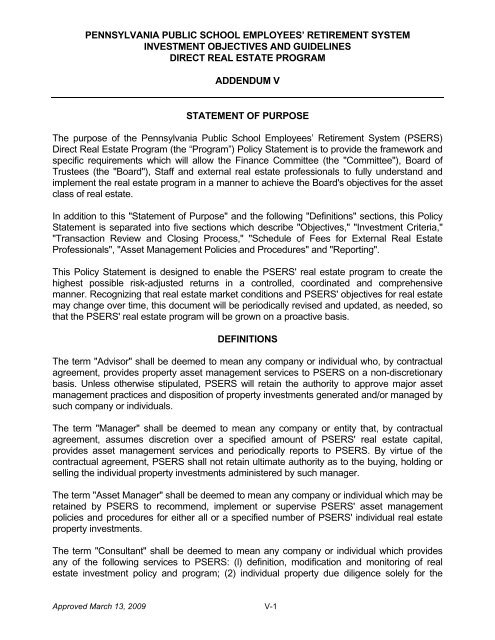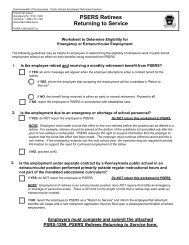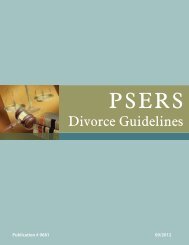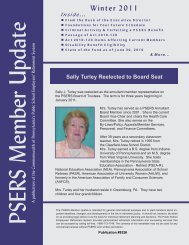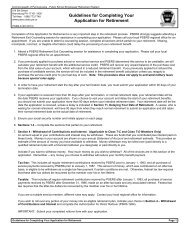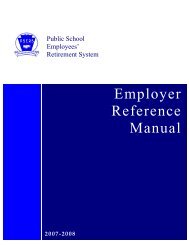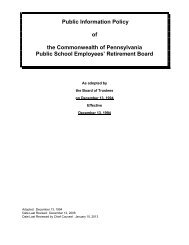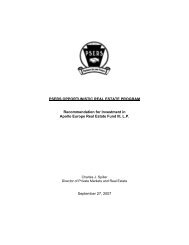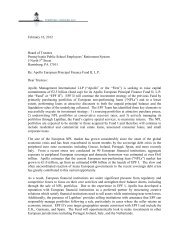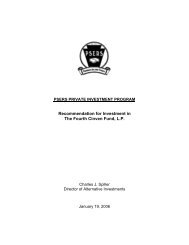Real Estate Program - psers
Real Estate Program - psers
Real Estate Program - psers
You also want an ePaper? Increase the reach of your titles
YUMPU automatically turns print PDFs into web optimized ePapers that Google loves.
PENNSYLVANIA PUBLIC SCHOOL EMPLOYEES’ RETIREMENT SYSTEM<br />
INVESTMENT OBJECTIVES AND GUIDELINES<br />
DIRECT REAL ESTATE PROGRAM<br />
ADDENDUM V<br />
STATEMENT OF PURPOSE<br />
The purpose of the Pennsylvania Public School Employees’ Retirement System (PSERS)<br />
Direct <strong>Real</strong> <strong>Estate</strong> <strong>Program</strong> (the “<strong>Program</strong>”) Policy Statement is to provide the framework and<br />
specific requirements which will allow the Finance Committee (the "Committee"), Board of<br />
Trustees (the "Board"), Staff and external real estate professionals to fully understand and<br />
implement the real estate program in a manner to achieve the Board's objectives for the asset<br />
class of real estate.<br />
In addition to this "Statement of Purpose" and the following "Definitions" sections, this Policy<br />
Statement is separated into five sections which describe "Objectives," "Investment Criteria,"<br />
"Transaction Review and Closing Process," "Schedule of Fees for External <strong>Real</strong> <strong>Estate</strong><br />
Professionals", "Asset Management Policies and Procedures" and "Reporting".<br />
This Policy Statement is designed to enable the PSERS' real estate program to create the<br />
highest possible risk-adjusted returns in a controlled, coordinated and comprehensive<br />
manner. Recognizing that real estate market conditions and PSERS' objectives for real estate<br />
may change over time, this document will be periodically revised and updated, as needed, so<br />
that the PSERS' real estate program will be grown on a proactive basis.<br />
DEFINITIONS<br />
The term "Advisor" shall be deemed to mean any company or individual who, by contractual<br />
agreement, provides property asset management services to PSERS on a non-discretionary<br />
basis. Unless otherwise stipulated, PSERS will retain the authority to approve major asset<br />
management practices and disposition of property investments generated and/or managed by<br />
such company or individuals.<br />
The term "Manager" shall be deemed to mean any company or entity that, by contractual<br />
agreement, assumes discretion over a specified amount of PSERS' real estate capital,<br />
provides asset management services and periodically reports to PSERS. By virtue of the<br />
contractual agreement, PSERS shall not retain ultimate authority as to the buying, holding or<br />
selling the individual property investments administered by such manager.<br />
The term "Asset Manager" shall be deemed to mean any company or individual which may be<br />
retained by PSERS to recommend, implement or supervise PSERS' asset management<br />
policies and procedures for either all or a specified number of PSERS' individual real estate<br />
property investments.<br />
The term "Consultant" shall be deemed to mean any company or individual which provides<br />
any of the following services to PSERS: (l) definition, modification and monitoring of real<br />
estate investment policy and program; (2) individual property due diligence solely for the<br />
Approved March 13, 2009 V-1
enefit of PSERS; (3) recommendations which relate to establishment or termination of<br />
relationships with Advisors, Managers, Joint Venture Partners or Asset Managers; (4)<br />
monitoring of and reporting on real estate investment performance and portfolio composition<br />
characteristics; and (5) unless otherwise stipulated, PSERS will retain the authority to approve<br />
the acquisition, major asset management practices and disposition of property investments<br />
generated and/or managed by such company or individuals.<br />
Preference shall be shown by PSERS for the hiring and retention of advisors, managers,<br />
asset managers and consultants who function in a fiduciary capacity.<br />
The term “Submitter” shall be deemed to mean any company or individual that proposes<br />
property investment opportunities to PSERS.<br />
OBJECTIVES<br />
The <strong>Program</strong> was closed to new acquisitions several years ago and is currently going through<br />
an orderly liquidation process.<br />
LEGAL INVESTMENTS<br />
PSERS has determined that it is appropriate to make legal investments in real estate as a<br />
separate asset class. Legal investments are those that are permissible under existing state<br />
and federal statutes, regulations and rulings. All such investments must be exclusively<br />
controlled by the Board. Control by the Board does not preclude its delegation of investment<br />
responsibilities to the Committee, or to PSERS' staff, or to PSERS' Advisors and Managers if<br />
such delegation is determined by the Board to be prudent.<br />
PERFORMANCE<br />
The real estate portfolio will be expected to achieve a minimum, long-term six percent (6%)<br />
real (inflation adjusted) rate of return. It is intended that this real rate of return objective be<br />
achieved at the portfolio level and thus, the projected real rate of return over the holding<br />
period of any individual investment need not achieve six percent if the investment assists the<br />
real estate portfolio in meeting overall objectives and complies with other content of this Policy<br />
Statement.<br />
Acceptable return for any individual investment will be determined within the context of:<br />
a) The role of that investment in enabling PSERS' overall real estate portfolio to<br />
meet its objectives.<br />
b) The anticipated components of overall return (income and appreciation), as<br />
related to the type of property, location, investment structure, property life cycle<br />
stage, tenant mix and quality of the income stream.<br />
c) The degree of risk associated with the investment in terms of the foregoing<br />
composition categories.<br />
Approved March 13, 2009 V-2
It is PSERS' intent to terminate (sell) any investment at the point in time when its value has<br />
been maximized to PSERS' portfolio. Therefore, while PSERS considers real estate a<br />
long-term asset class, each investment position will be continually monitored and disposition<br />
strategies will be in place so that transactions are able to occur to maximize individual<br />
investment profitability and value.<br />
DIVERSIFICATION<br />
The PSERS' real estate program will be prudently diversified by investment structure,<br />
investment method, property type, property value, investment value, property life cycle stage,<br />
and economic region in order to minimize the impact of secular or cyclical changes in the<br />
economy, financial markets and/or real estate markets. Consequently, this Policy Statement<br />
will address diversification among all foregoing portfolio composition characteristics.<br />
RISK MANAGEMENT<br />
For the purpose of focusing on maximized risk-adjusted returns, preservation of investment<br />
capital and implementation of appropriate asset management procedures, a basis of the real<br />
estate program is the management of risk.<br />
Categories of risk which will be analyzed and understood prior to the funding of any<br />
investment or the establishment (or re-establishment) of any asset management plan include<br />
real estate market risk, financial risk, business risk and environmental hazard risk. Therefore,<br />
no investment will be consummated without full assessment of lease structures and tenant<br />
mixes as related to the quality of income streams, the reasonableness of economic property<br />
operating forecasts and a complete analysis of all physical property and market area<br />
characteristics.<br />
A major factor of risk management is the monitoring of portfolio performance and composition<br />
so that active strategies may be implemented from time to time to improve overall risk<br />
adjusted performance at the portfolio level.<br />
Another critical factor to effective risk management is market awareness, specifically as it<br />
applies to real estate market conditions and trends. Therefore, PSERS' real estate program<br />
will take into consideration such factors as relative capital intensity in the marketplace;<br />
availability of quality products, opportunities and investment vehicles; and achievable yields<br />
and internal rates of return.<br />
The primary emphasis for creation and expansion of the real estate program will be on that<br />
component of the portfolio that will consist of operating, income producing properties. This<br />
component will primarily consist of completed and substantially leased properties with a<br />
trackable performance history and leasing cycles. An asset will be classified in this category<br />
based upon the relative predictability of future cash flows. The property types in this category<br />
will generally consist of high quality, well-located office, retail, industrial and multi-family<br />
residential properties. Locations of these assets will be generally limited to major metropolitan<br />
areas throughout the United States that have demonstrated a resilience to major economic or<br />
real estate market recessionary conditions, and markets which are characterized by new<br />
supply constraints. The targeted net real internal rate of return for these investments is a<br />
Approved March 13, 2009 V-3
minimum of 6.0%. A minimum of seventy-five percent (75%) (weighted by investment value)<br />
of the real estate portfolio shall be allocated to operating, income producing investments.<br />
PSERS may also invest in other assets as a supplement to the operating, income producing<br />
investment program. The other assets may include non-traditional property types and/or<br />
properties that involve development, re-development or leasing risks and may require<br />
specialized acquisition or management expertise to enhance the value of the investment. An<br />
asset may be classified as other based upon the relative unpredictability and/or instability of<br />
future cash flows. Given the higher risk profile of these assets, the return requirements are a<br />
minimum of 200 to 300 basis points above the operating, income producing portfolio return<br />
requirements. In addition, the holding period for the other investments will generally be less<br />
than that of the operating, income producing portfolio and each other investment must include<br />
a thorough and well-defined exit strategy. A maximum of fifteen percent (15%) (weighted by<br />
investment value) of the Board's real estate allocation shall be available for other investments.<br />
In addition to operating, income producing and other assets, PSERS may also invest in<br />
specialized investments such as agriculture and timber in accordance with the Policy<br />
Statement. A maximum of ten percent (10%) (weighted by investment value) of the real<br />
estate portfolio shall be allocated to such specialized investments.<br />
DISCRETION<br />
<strong>Real</strong> estate investment decisions and recommendations will be guided by the "prudent expert"<br />
standard, embracing the prudent decision-making process typically employed by experts in<br />
the areas of real estate acquisition, operation, management and disposition.<br />
PSERS will retain discretion over the decision to invest after detailed analysis, due diligence<br />
and underwriting of the investment proposal and will retain discretion over the adoption,<br />
implementation and maintenance of management and operating policies and procedures, as<br />
outlined in this Policy Statement.<br />
PSERS approval will be required for the funding of capital and for major operational,<br />
management and disposition activities.<br />
The Board may, through delegations of authority, permit PSERS' real estate staff to<br />
implement the real estate program by having discretion over specified investment program<br />
decisions (as outlined in this Policy Statement).<br />
Approved March 13, 2009 V-4
INVESTMENT CRITERIA<br />
INTRODUCTION<br />
The following criteria are applied only to PSERS' "hard asset" real estate and not securitized<br />
real estate or real estate financial instruments such as options and credit enhancements.<br />
Emphasis will be placed on the degree of equity orientation, level of security, potential<br />
risk-adjusted returns and compliance with all content of this Policy Statement for each<br />
investment opportunity.<br />
While the investment criteria specified herein will apply most directly to specified individual<br />
property investments, they also will be used by PSERS and its Consultant to review and<br />
evaluate the underlying characteristics and strategies of the commingled funds to which<br />
PSERS may allocate real estate capital.<br />
Each section of these investment criteria will be used in conjunction with all other sections so<br />
that any potential investment must meet a wide range of underwriting requirements in order to<br />
qualify for consideration by PSERS.<br />
INVESTMENT STRUCTURES<br />
PSERS will give first priority to investing in specified properties where PSERS will be the sole<br />
investor or in which it can obtain a controlling interest. Exceptions may be made in the case of<br />
extremely large transactions or transactions which may involve portfolios of properties.<br />
INVESTMENT METHODS<br />
PSERS may utilize the following structures in implementing the real estate investment<br />
program:<br />
UNLEVERAGED ACQUISITIONS: Since emphasis is placed on the degree of equity<br />
orientation and minimization of financial risk, PSERS has a preference for acquiring properties<br />
not encumbered by debt.<br />
LEVERAGED ACQUISITIONS: PSERS will typically not acquire any property on a leveraged<br />
basis unless the property is encumbered by "well-margined," traditional debt providing<br />
"positive leverage."<br />
EQUITY-ORIENTED DEBT: Properly structured participating or participating/convertible debt<br />
investments may be considered. Any such mortgage financing will normally be senior to all<br />
other debt and ground leases (except in the event of a PSERS' combined position as a<br />
ground lessor/leasehold lender). Loan structuring features shall typically include a pay rate<br />
equal to the contract interest rate, acceptable debt service coverage by actual cash flow from<br />
the property, satisfactory participation levels in annual and residual income and value, a<br />
proper conversion option and creditworthy borrowers. In order to be classified as equity real<br />
estate, equity-oriented debt investments should be structured to provide more than a 25%<br />
participation in net cash flow or sales proceeds.<br />
Approved March 13, 2009 V-5
TRADITIONAL DEBT: PSERS may, as a part of its real estate program, make traditional<br />
mortgage loans (straight debt without significant equity participation features) with the<br />
intention to enhance current portfolio cash yields. Such investments should be secured by first<br />
mortgages on real estate bearing either fixed or floating interest rates. The underwriting of<br />
such mortgage loans shall include the same structuring features enumerated above for<br />
equity- oriented debt and consideration for a cash yield premium to reflect the lack of<br />
significant or any participation features. Debt that is structured to provide 25% or less<br />
participation in net cash flow or sales proceeds will be classified as traditional debt.<br />
EQUITY/DEBT COMBINATIONS: Equity/debt combination investment opportunities will be<br />
underwritten according to PSERS' requirements for both ownership and mortgage loan<br />
investments. Such investments may include investment positions as both an owner and<br />
lender in the same asset, separated equity and debt positions in a portfolio of assets or land<br />
ownership and leasehold lending for one or more specified assets.<br />
JOINT VENTURE: Properly structured joint ventures, defined as any asset of which less than<br />
100% is owned by PSERS, may also be considered. The underwriting of such an investment<br />
will include an analysis of the joint venture partner(s) in addition to the normal underwriting of<br />
a proposed transaction.<br />
PROPERTY STATUS<br />
PSERS may invest in the following stages of a property's investment life cycle:<br />
OPERATING: PSERS has a preference for investing in operating properties. Operating<br />
properties refer to those properties that have a physical and financial record and are<br />
substantially (80% or greater) leased. Such properties have typically experienced at least one<br />
full tenant leasing cycle and have a relatively mature tenant mix.<br />
LEASING: PSERS may consider properties that are in the leasing stage of the investment life<br />
cycle. Properties in the leasing stage are defined as being fully completed and ready for<br />
occupancy but not fully occupied (less than 80% leased). Acceptance of a relative degree of<br />
risk of properties in the leasing cycle should be offset by overall yield potential and fulfillment<br />
of other portfolio objectives. Typically, guarantees or other financial instruments will be a<br />
PSERS' requirement to reduce leasing risk.<br />
DEVELOPMENTAL: PSERS may consider developmental properties, defined as those under<br />
construction or in a pre-construction phase. Typically, appropriate financial guarantees will be<br />
required to avoid or minimize developmental and leasing risk.<br />
RE-DEVELOPMENTAL: PSERS may consider rehabilitative or redevelopment properties,<br />
defined as those typically having functional and/or economic obsolescence to the extent that<br />
correction of these conditions can create a meaningful economic improvement for the<br />
property.<br />
Approved March 13, 2009 V-6
OPPORTUNISTIC: Appropriate for inclusion in PSERS' investment criteria are opportunistic<br />
or "value-added" properties that may not fall into the foregoing property status categories.<br />
Such properties are defined as those whose current financial condition and value may be<br />
substantially enhanced by innovative asset management and/or financial structuring<br />
techniques.<br />
For developmental re-developmental and opportunistic properties, PSERS may consider the<br />
issuance of forward purchase or funding letters. Such commitment letters should contain<br />
stringent completion, occupancy and cash flow achievement and require funding within a<br />
specific time period from the date of the issuance of the commitment letter. PSERS shall<br />
attempt to receive a satisfactory, non-refundable commitment fee for such forward<br />
commitments.<br />
TENANT MIX<br />
A reasonable mix of national credit tenants, regional or local credit tenants and other local<br />
tenants is typically necessary for all property types except residential, land, timber and<br />
agriculture. It is mandatory to create and maintain an appropriate balance of tenant types.<br />
Investment in single-tenant properties is included in PSERS' investment criteria, but such<br />
properties must typically generate highly competitive immediate cash yields. Emphasis will be<br />
placed on properties (excluding timber and agriculture) with a design and location conducive<br />
to conversion to multiple tenant use at the time of lease expiration.<br />
PROPERTY LOCATIONS<br />
PSERS' real estate investments will be diversified across economic regions to allow for<br />
competitive portfolio performance in the event of a temporary weakness in any one region and<br />
to allow for differing urban and suburban market trends within any metropolitan area.<br />
Economic region diversification will include consideration of New England, MidAtlantic, South,<br />
Industrial Midwest, Central Plains, Energy States, Pacific Southwest and Pacific Northwest<br />
locations.<br />
Typically, PSERS will limit its investments in any one Primary Metropolitan Statistical Area<br />
(PMSA) to ten percent (10%) of the total investment value of its real estate portfolio. However,<br />
exceptions may be made for the metropolitan areas of Philadelphia and Pittsburgh,<br />
Pennsylvania.<br />
After the establishment of a broad economic regional mix within the portfolio, preference may<br />
be given to investments throughout Pennsylvania consistent within the content of this Policy<br />
Statement.<br />
PSERS may consider investing in real estate located in countries other than the United<br />
States. However, criteria and other requirements for foreign real estate are not included<br />
herein. No foreign investment may be consummated until the adoption by PSERS of an<br />
expanded Policy Statement specific to foreign real estate investment and management<br />
issues.<br />
Approved March 13, 2009 V-7
PROPERTY TYPES<br />
The property types that PSERS may consider are:<br />
OFFICE: Acceptable subcategories within the office property type include low-rise<br />
business/technological parks, mid-rise properties, and high-rise buildings. PSERS shall<br />
pursue office properties located in central business districts, suburbs of major urban areas<br />
and infill sites.<br />
RETAIL: Shopping centers acceptable for investment include regional malls, mini-regional<br />
malls, community centers, and (on a very selective basis) neighborhood centers.<br />
Provided appropriately strong asset management is available, PSERS shall give priority to<br />
investing in shopping centers which have strong occupancy but may be in need of revised<br />
tenant mixing, cosmetic improvements and more innovative management, and which have<br />
the potential for expansion.<br />
Full-line shopping centers, rather than specialty, off-price or discount only centers, shall<br />
receive investment priority.<br />
INDUSTRIAL: Industrial properties acceptable for investment include industrial parks and<br />
buildings located within industrial parks, rather than free-standing buildings. Uses may include<br />
light manufacturing, warehouse, research, incubator space, self-storage and combinations of<br />
the foregoing with office space.<br />
RESIDENTIAL: The preferred type of residential real estate is multi-family housing. Rental<br />
projects under consideration shall have appropriate tenant restrictions in place without being<br />
discriminatory as to race, religion, color, national origin, physical handicap, medical condition,<br />
marital status, sex or age.<br />
Such properties shall typically have histories of producing relatively stable income streams,<br />
evidencing an ability to increase income over time at rates greater than the then-current<br />
inflation rate. In addition, primary consideration will be given to those properties located where<br />
there is no threat of rent control and which have obtained preliminary governmental approval<br />
for future conversion to ownership housing.<br />
A subcategory of residential real estate that may be considered is retirement housing.<br />
MIXED-USE: Such properties are defined as those with more than one use and which are of<br />
greater overall economic value than the sum of the values of their individual uses. They shall<br />
be underwritten based on PSERS' requirements for all separate uses contained therein.<br />
LAND: Two categories of land are included in PSERS' investment criteria: land under existing<br />
income producing improvements and undeveloped land.<br />
First priority will typically be given to land under existing, income producing improvements or<br />
improvements under construction. Preferably a land lease shall not be subordinated to debt<br />
on the improvements (with the exception of PSERS' own debt), thus allowing a priority cash<br />
distribution.<br />
Approved March 13, 2009 V-8
The second category of acceptable land is land in the predevelopment stage, but only under a<br />
strict set of conditions. Such land transactions shall be structured so that PSERS has the<br />
alternatives of retaining the land under a ground lease, selling the land to a development or<br />
other holding entity, participating in the future development process or subdividing and selling<br />
all or a part of the property.<br />
AGRICULTURE: Acceptable agriculture properties include farmlands of good quality located<br />
in primary farming regions contiguous to well-established agricultural infrastructures.<br />
Emphasis will be given to properties with traditional row crops and common permanent crops.<br />
Acceptable investment properties should have the ability to efficiently and consistently provide<br />
above average crop yields. Properties should be of sufficient size to allow an efficient<br />
operation and should be of similar size to properties within the local market area.<br />
TIMBER: Acceptable investment properties should include good quality, professionally<br />
managed timber that is in close proximity to well-established timberland infrastructure and is<br />
of a sufficient size to allow efficient harvesting techniques and operation. Timberland<br />
investments may include properties in various timber production life cycle stages.<br />
ENVIRONMENTAL HAZARDS<br />
PSERS will only invest in properties that fully comply with all local, state and federal<br />
governmental environmental-related regulations. PSERS may consider properties that are<br />
affected by environmental hazards, but only after a satisfactory, systematic evaluation of each<br />
prospective investment so affected. Major pre-investment considerations include the potential<br />
risks, liabilities, corrective work and costs associated with the presence and management of<br />
environmental hazards. The potential risks should be viewed as being self-insured, since the<br />
amount of insurance available to cover same is virtually non-existent. Therefore, quantification<br />
of potential liability must be made prior to investment.<br />
TRANSACTION SIZES<br />
Individually specified properties shall not generally be less than $10 million of investment size.<br />
In the event portfolios are acquired, individual property sizes shall generally be a minimum<br />
size of $5 million; however, they may be smaller if all the properties are located at the same<br />
site or the property(ies) is(are) within the Commonwealth of Pennsylvania. No individual<br />
investment shall typically exceed one percent (1.0%) of the total PSERS' investment portfolio.<br />
Approved March 13, 2009 V-9
TRANSACTION REVIEW AND CLOSING PROCESS<br />
SPECIFIED PROPERTY INVESTMENTS<br />
PSERS’ staff, in conjunction with the Consultant, shall be responsible for the presentation of<br />
investment proposals to the Committee/Board.<br />
Origination and Review Process<br />
All proposals by Submitters (or other transaction originators) shall be entered into the PSERS'<br />
Activity Log that shall be maintained by PSERS' Managing Director of Private Markets and<br />
<strong>Real</strong> <strong>Estate</strong> (MDPMRE). All proposals by the Submitters shall be made in writing. Once said<br />
entry has been made, the Submitters shall be protected as the transaction originator. The<br />
investment brief shall contain the following major categories of information:<br />
1. Cover Letter<br />
a) Preliminary summary of the merits of the proposed transaction<br />
b) Preliminary summary of downside risks<br />
2. Property Profile<br />
a) Location<br />
b) Physical description<br />
c) Age<br />
d) Summary of major tenants<br />
3. Market Description<br />
a) A brief assessment of the marketplace including competition<br />
4. Preliminary investment structure<br />
a) Acquisition price (or loan amount)<br />
b) Basic transaction terms<br />
c) Projected closing date<br />
d) Legal and operational aspects of the investment entity<br />
e) Preliminary pro forma cash flow for a minimum of ten (10) years from the date<br />
of closing, showing all source and types of income and expenses, including all<br />
assumptions.<br />
f) Preliminary projections of initial cash yield and internal rate of return to PSERS<br />
on both a gross and net basis.<br />
Approved March 13, 2009 V-10
When the MDPMRE determines that the proposal warrants further consideration, the<br />
Submitter shall prepare and deliver to the MDPMRE and Consultant a formal investment<br />
package within 45 days of notification. The formal investment package shall contain the<br />
following information:<br />
1. An executed letter of intent with the proposed seller or borrower, and/or other<br />
correspondence indicating Submitter control over the deal.<br />
2. A statement confirming that the investment is still available on the terms specified in<br />
the investment brief.<br />
3. Changes, if any, in the content of the previously submitted investment brief.<br />
4. Risk and return evaluation<br />
a) Narrative analysis of risk and yield potential from the property's existing and<br />
potential economics, leasing structure, physical attributes and location within its<br />
marketplace.<br />
b) Statement of historical income and expenses of the property for a minimum of<br />
three (3) years, or since its completion (if less than three years old), preferably<br />
audited or certified by an auditor.<br />
c) Pro forma cash flow for a minimum of ten (10) years from the date of closing,<br />
showing all sources and types of income and expenses.<br />
d) Annual projections of gross and net cash flow to PSERS showing all advisor<br />
fees.<br />
e) Projection of gross and net internal rates of return to PSERS.<br />
f) Specification of all assumptions utilized in the cash flow projections.<br />
g) Sensitivity analysis assuming both downside and upside variables in market<br />
rents, vacancy factors and terminal capitalization rates.<br />
5. Complete rent roll.<br />
6. A reputable third party <strong>Real</strong> <strong>Estate</strong> Consulting firm’s review of the property's market<br />
area and immediate neighborhood and the Submitter’s analysis of the subject<br />
property's competitiveness within its market area.<br />
7. Comprehensive description of all physical characteristics, especially as they relate to<br />
physical or functional obsolescence.<br />
8. Statement of valuation based on market sales analysis, replacement cost analysis,<br />
income analysis, including a valuation conclusion.<br />
9. An analysis of the on-site management and leasing, including fees and capabilities.<br />
10. A preliminary long-term asset management plan, including disposition strategies.<br />
11. Such additional information as may be relevant or necessary, as the Consultant or the<br />
MDPMRE may determine.<br />
Approved March 13, 2009 V-11
Approval and Closing Process<br />
After review of an investment package, the Consultant shall inform the MDPMRE of its<br />
conclusions and recommendations regarding the investment opportunity.<br />
Upon concurrence by the MDPMRE and Consultant of the validity of an investment<br />
opportunity, the investment will be scheduled as an agenda item at the next possible<br />
Committee meeting. The MDPMRE may inform the Submitter of preliminary staff level<br />
approval of a transaction, but shall indicate to the Submitter that formal approval requires<br />
Committee and Board concurrence.<br />
Immediately following Committee approval the MDPMRE shall schedule the investment as an<br />
agenda item at the next possible Board meeting. The MDPMRE may inform the Submitter of<br />
Committee approval, but shall inform the Submitter that formal approval requires Board<br />
action.<br />
Immediately following Board approval, the MDPMRE and Consultant will prepare a formal<br />
notice of approval to be sent to the Submitter/Seller, including specification of all conditions of<br />
closing. Within ten (10) working days of Submitter’s/Seller’s receipt of said notification of<br />
approval, the Submitter/Seller shall provide in writing to the MDPMRE and Consultant<br />
evidence that the Seller of the subject transaction has formally agreed to all PSERS’<br />
conditions of closing and shall specify a closing date acceptable to PSERS.<br />
Within 30 days of Advisor receipt of formal notice of approval, Submitter/Seller will prepare or<br />
cause to be prepared and delivered to the MDPMRE and Consultant the following:<br />
1. Complete market analysis demonstrating the subject property's competitiveness within<br />
its market area.<br />
2. A complete environmental hazard analysis including a preliminary risk management<br />
plan.<br />
3. Any other information that PSERS may require as a condition to closing. (PSERS may<br />
require, on a case-by-case basis, an independent appraisal.)<br />
At the next Committee and Board meetings following a staff level investment approval, the<br />
MDPMRE will submit an executive summary of the transaction. Documents relating to any<br />
such investment will be executed in accordance with PSERS' standard policy, i.e., by any 2 of<br />
the individuals holding the following positions: Executive Director, Chief Investment Officer or<br />
Assistant Executive Director.<br />
The MDPMRE will request that the Deputy Chief Counsel - Investments request that the<br />
Pennsylvania Office of General Counsel designate outside legal counsel experienced in real<br />
estate to assist in the closing. This process will be under the direct supervision of PSERS’<br />
Chief Counsel who will be required to sign off as to his or her satisfaction of all legal issues<br />
related to the property, the investment structure and the documentation prior to the closing<br />
date in order for a closing to occur.<br />
Approved March 13, 2009 V-12
Upon completion of the generation, review and approval of all closing checklist items, a letter<br />
must be sent by the Seller to the MDPMRE and Consultant stating the following:<br />
1. All conditions to closing have been met (or list all outstanding items and their status);<br />
and<br />
2. To the best of the Seller’s knowledge, there have been no changes since the time of<br />
approval of any physical property, market area or economic factors which could cause<br />
the investment to be of any lower quality than that which was approved or identify any<br />
such changes and evaluate its effect upon the proposed investment.<br />
No closing will occur without formal sign-off of the closing letter by the Consultant, MDPMRE<br />
and the Chief Investment Officer.<br />
As soon as practical after closing, PSERS’ Legal Division will provide, or cause to be<br />
provided, to the MDPMRE a closing binder (or binders) containing all pertinent<br />
documentation, approved asset management plans and various exhibits demonstrating<br />
performance and operational monitoring and reporting systems. The closing documents will<br />
be maintained in the PSERS home office files or at the Pennsylvania Treasury, as<br />
appropriate.<br />
Approved March 13, 2009 V-13
SCHEDULE OF FEES FOR EXTERNAL REAL ESTATE PROFESSIONALS<br />
INTRODUCTION<br />
The schedule of fees which PSERS pays to its Advisors, Managers and Consultants is based<br />
primarily on the consideration of achieving satisfactory net (after fee) returns and receipt of<br />
professional, competent services as required by this Policy Statement. Fees shall be<br />
structured with emphasis on:<br />
1. Fair compensation related to the quality of services;<br />
2. Relationship to original cost or fair market value of assets, as objectively determined<br />
and/or upon income as PSERS may deem appropriate;<br />
3. Emphasis on asset management, rather than brokerage-type services;<br />
4. Provision of high quality property level as well as portfolio level services;<br />
5. Implementation of long-term asset management plans designed to maximize value<br />
over entire anticipated asset holding periods;<br />
6. Potential for unbundling services, as appropriate, property by property;<br />
7. Ability to terminate services without penalty fees.<br />
ADVISOR AND MANAGER FEES<br />
It is PSERS' intent to retain flexibility to negotiate fee schedules that make distinction among<br />
services provided by differing Advisors or Managers, differing investment strategies and<br />
differing investment structures.<br />
Although PSERS' fee schedules may require breakpoints based on transaction sizes,<br />
amounts of capital invested or the size of any Advisor's/Manager's PSERS portfolio, emphasis<br />
will be placed on the need to manage each asset on a property-by-property basis.<br />
Advisor compensation shall be determined on an individual contract basis, and Manager fees<br />
shall be governed by the terms of commingled fund documentation approved by PSERS in<br />
advance of funding. Advisor and Manager fees may be "flat" or "performance based." For<br />
the latter fee structure, it is PSERS' intent to structure performance-based fees to achieve the<br />
following:<br />
1. Minimize or eliminate front-end "load";<br />
2. Minimize ongoing annual fees until a negotiated "threshold" return has been received<br />
by PSERS;<br />
3. Advisor/Manager participation in profitability only after the threshold return has been<br />
received;<br />
Approved March 13, 2009 V-14
4. Definition of the threshold return expressed in real (inflation adjusted) terms;<br />
5. Definition of achievement of the threshold return at a portfolio, rather than individual<br />
deal level.<br />
CONSULTANT FEES<br />
Consultants shall be paid on a retainer fee basis as determined by the terms of a negotiated<br />
consultant contract. The Consultant shall not typically be paid on any basis related to the<br />
following:<br />
1. Closing of individual transactions;<br />
2. Asset management services;<br />
3. Performance of the PSERS' real estate portfolio or individual assets therein;<br />
4. In any other manner that would conflict with advisory or managerial services and fees<br />
paid to Advisors and Managers.<br />
Approved March 13, 2009 V-15
ASSET MANAGEMENT AND POLICY PROCEDURES STATEMENT<br />
INTRODUCTION<br />
The term "asset management" as it pertains to PSERS' real estate investment program<br />
encompasses all activities relating to the operations of acquired or financed specified property<br />
real estate investments.<br />
RESPONSIBILITIES<br />
Asset Managers may be authorized by the MDPMRE to:<br />
1. Recommend annual operating and capital budgets for property assets.<br />
2. Execute property level contracts with service providers.<br />
3. Recommend or select special project professionals such as engineers, appraisers and<br />
property managers.<br />
4. Negotiate proper insurance coverage.<br />
5. Ensure that all property level taxes and assessments are paid on a timely basis.<br />
6. Approve and execute contracts for capital improvements on any property that are in<br />
accordance with a budget previously approved by PSERS.<br />
7. Approve and execute leases that are consistent with the leasing guidelines contained<br />
in the annual business plan.<br />
8. Recommend property disposition strategies and opportunities for properties under their<br />
management.<br />
9. Provide property level operational and economic information as required by the<br />
MDPMRE to facilitate appraisal, audit and reporting practices.<br />
10. Protect and defend PSERS' interests in any property as may be warranted by any<br />
event of an emergency or extenuating nature.<br />
The MDPMRE shall:<br />
1. Review and authorize annual operating budgets for all property assets.<br />
2. Review and authorize capital budgets for all normal capital budget items for each<br />
property. Normal capital budget items include lease-related tenant improvements,<br />
leasing commissions, and other capital expenditures related to the ongoing and routine<br />
maintenance of the property.<br />
Approved March 13, 2009 V-16
3. Together with the Chief Investment Officer, approve budgets for extraordinary<br />
operating and capital items as recommended by Asset Managers for amounts not to<br />
exceed PSERS’ annual expenditures of $5 million per property. The MDPMRE shall<br />
be responsible for giving written notice of such approvals to the Executive Director.<br />
4. Approve for execution all property management and leasing agreements, modifications<br />
and amendments.<br />
5. As circumstances warrant, select, or approve external Asset Manager selection of,<br />
special project professionals such as engineers, appraisers and property managers.<br />
6. On recommendation by the Consultant and with concurrence of the Chief Investment<br />
Officer, take such action as may be necessary to enhance, protect or preserve the<br />
Fund's real estate assets when a decision cannot be postponed in order to seek Board<br />
approval.<br />
7. On recommendation by an Advisor and concurrence by the legal office or appointed<br />
counsel, take such action as may be necessary to enforce the rights and remedies of<br />
the Board to the fullest extent of the law and/or otherwise available under the Board's<br />
mortgage and other real estate documentation.<br />
8. Report to the Committee and Board on actions taken under these and other<br />
delegations of authority that may have significant effect on the value of any real estate<br />
asset or the real estate portfolio.<br />
9. Make certain that the appropriate types and levels of insurance are in force at all<br />
properties to include multi-peril, general liability and rental income recovery; that Asset<br />
Managers have in force appropriate levels of errors and omissions insurance; and that<br />
Property Managers have in force reasonable levels of liability insurance -- all of which<br />
should be evidenced by appropriate certificates of coverage on file in PSERS' offices.<br />
10. Supervise external Advisor, Manager and Consultant compliance with all requirements<br />
of this Policy Statement.<br />
Board approval shall be required for the sale, refinancing, retirement or other substantive<br />
changes of all or any fractional ownership or other interest in any property asset or investment<br />
position.<br />
PRELIMINARY POLICIES AND PROCEDURES<br />
The MDPMRE and Consultant shall prepare or caused to have prepared preliminary asset<br />
management policy statements during the transaction review and closing process prior to<br />
funding or non-conditional commitment to fund any property investment.<br />
A preliminary asset management policy and procedures statement will include:<br />
1. Identification of potential property managers and leasing agents.<br />
2. Structures of leases.<br />
Approved March 13, 2009 V-17
3. Environmental risk management plan.<br />
4. Market positioning related to competitive properties and other market influences.<br />
5. Reporting timing procedures and methodology.<br />
6. Preliminary disposition strategies.<br />
ASSET MANAGEMENT POLICIES AND PROCEDURES<br />
Within forty-five (45) days from the date an asset is transferred, the Advisor or Manager shall<br />
provide the MDPMRE and the Consultant with an asset management policies and procedures<br />
plan.<br />
The plan must be updated by the Advisor and submitted for the review by the MDPMRE<br />
within 45 days of each calendar year-end. Annual asset management review meetings will be<br />
scheduled with the MDPMRE (or his staff) and the Advisors. At the direction of the<br />
MDPMRE, the Consultant may be required to assist in reviewing the plan.<br />
The plan will contain the following sections:<br />
- Property Summary<br />
- Investment Objectives<br />
- Market Summary<br />
- Property Management and Leasing<br />
- Physical Property Review<br />
- Asset Evaluation<br />
- Operating and Capital Budgets and Financial Comparisons<br />
- Hold/Sell Recommendation and Disposition Plan<br />
The contents of each section are described below:<br />
Property Summary:<br />
The property summary is a one page summary that includes: a brief description of the site<br />
and the improvements including parking and rentable area; most recent property valuation<br />
and occupancy information; and identification of any critical issues or events that may<br />
significantly impact the value of PSERS' investment.<br />
Investment Objectives:<br />
Investment objectives identify the major long-term (more than five years) intermediate-term<br />
(two to five years) and short-term (one year) goals for the property. An estimated time frame<br />
for achievement of each goal must be specified.<br />
Approved March 13, 2009 V-18
Market Summary:<br />
The market summary discusses overall leasing, occupancy and purchase/sales activity within<br />
the market area. It also identifies major competitive projects and their physical and financial<br />
characteristics. These characteristics may include: location, condition, ingress/egress,<br />
amenities, physical appearance, occupancy lease rates and value.<br />
Property Management and Leasing:<br />
This section establishes guidelines for new leases considering market conditions and the<br />
competitive position of the property. Guidelines must be established for rent levels, building<br />
and tenant improvements, leasing commissions and rental concessions. Parameters may be<br />
segmented for different sections of the property (e.g. storage space, high-rise office and<br />
ground floor retail). The marketing and tenant retention strategies must be discussed<br />
including specific leasing and occupancy goals and the methods that will be used to achieve<br />
them. The tenant Retention Strategy must specifically identify leases expiring over the<br />
intermediate-term (five year period) and the Advisors planned activities tenant retention<br />
strategies must be discussed including specific leasing and occupancy goals and the methods<br />
which will be used to achieve them. The tenant Retention Strategy must specifically identify<br />
for renewal of those tenants. Tenants that have decided not to renew must be specifically<br />
identified and a brief explanation provided.<br />
Physical Property Review:<br />
Based on the Advisor's site inspections, this section describes the physical condition of the<br />
property and its major systems (e.g., HVAC, elevators, landscaping, etc.). Necessary and<br />
planned improvements are discussed including the status of construction in progress.<br />
Planned testing for environmental hazards must be mentioned, with any existing or potential<br />
environmental hazards specifically identified. The actions taken or planned to abate the<br />
hazard must be explained including an estimated time frame for completion of the abatement.<br />
Asset Evaluation:<br />
This section evaluates the strengths, weaknesses, opportunities and threats for the property.<br />
It also identifies the property's relative position compared to its major competition.<br />
Operating and Capital Budgets and Financial Comparisons:<br />
Operating and capital budgets will be based on calendar years and shall be prepared for each<br />
property in substantial compliance with Exhibit II. The presentation will include a comparison<br />
with the prior year’s budget and actual activity of the prior year. All line items shall be reported<br />
on an accrual basis meaning that income is recorded as it is earned and expenses as they<br />
are incurred. As necessary, explanatory notes shall be incorporated into the budget<br />
presentation.<br />
Hold/Sell Recommendation and Disposition Plan:<br />
The Advisor will explicitly recommend that PSERS either hold or sell the asset. The<br />
recommendation may be different for portions of an investment (for example it may be<br />
Approved March 13, 2009 V-19
ecommended that one building be sold from an industrial park owned by PSERS). The<br />
reasons for the recommendation must be discussed with sufficient analysis to support the<br />
hold/sell recommendation. The analysis should include a discounted cash flow of the<br />
investment over its anticipated holding period.<br />
In addition to the hold/sell recommendation, the asset management plan will include an<br />
investment disposition plan with the following elements at a minimum:<br />
- Projected timing of sale that would maximize PSERS' holding period return<br />
- Anticipated structure of disposition (outright sale, partial sale, etc.)<br />
- Identification of potential buyers - by type, or identity, if possible<br />
- Process for implementation of disposition decisions including the use of brokers,<br />
engineers and other professionals<br />
- Estimated sales proceeds, costs of sale and net disposition proceeds<br />
- PSERS' projected internal rate of return over the projected holding period<br />
External Reporting:<br />
Property Managers and Leasing Agents:<br />
REPORTING<br />
• Advisors will establish monthly reporting guidelines for Property Managers and Leasing<br />
Agents.<br />
Advisors:<br />
Within 45 days of each calendar quarter, the Advisors will provide the MDPMRE with a report<br />
on each investment containing the following:<br />
• Property summary including property name, address, occupancy, and a brief<br />
description of its improvements and the investment structure<br />
• Current value accrual basis financial statements including a statement of Assets and<br />
Liabilities, and a Statement of Operations comparing the current period and year-todate<br />
activity to budget<br />
• Litigation report summarizing the status of any current of potential litigation<br />
• Update on the progress of each property in relation to its asset management plan<br />
goals and objectives specifically commenting on:<br />
• Marketing conditions (occupancy levels and trends, leasing and sales activity,<br />
etc.)<br />
• Property occupancy and leasing activity<br />
• Status of planned capital expenditures including environmental hazard<br />
abatement projects<br />
Approved March 13, 2009 V-20
• Critical factors or events that have significantly influenced or may potentially<br />
influence the investments performance<br />
• Recommended changes to the asset management plan<br />
• Explanation of material variances comparing the current quarter actual activity to<br />
budget for the following line items:<br />
• Effective gross income<br />
• Total operating expenses<br />
• Tenant improvements<br />
• Leasing commissions<br />
• Building improvements<br />
• Debt service<br />
A material variance is defined as actual activity that varies by more than 10% of budget<br />
in either direction.<br />
• Calculated gross (before Advisor fees) and net (after Advisor fees) returns to PSERS<br />
• Notes to all financial statements, including summary of encumbrances and co-venturer<br />
interests<br />
• In addition, such other reports as PSERS may require.<br />
The Consultant:<br />
Each calendar quarter the Consultant will prepare on an accrual basis an operating and status<br />
report on the entire PSERS' real estate portfolio. The report will be submitted to the<br />
MDPMRE.<br />
The report will contain the following information:<br />
1. Executive summary<br />
2. Current investment value of individual investments and the portfolio<br />
Approved March 13, 2009 V-21
3. Economic performance of individual investments, commingled funds and the portfolio,<br />
in terms of yields and returns:<br />
a) Time weighted<br />
1) Current quarter<br />
2) Last four quarters<br />
b) Dollar weighted<br />
1) Schedule of capital in/cash out<br />
2) Internal rate of return<br />
c) Components of yields<br />
1) Cash flow<br />
2) Appreciation<br />
4. Portfolio composition characteristics summary by:<br />
a) Property types<br />
b) Property locations<br />
c) Investment structures<br />
d) Investment values<br />
e) Property values<br />
f) Property life cycle stages<br />
The Consultant's quarterly reports will be delivered to PSERS within 90 days of the end of<br />
each calendar quarter. However, the reports will not be due to PSERS prior to thirty days<br />
from the Consultant's receipt of all information from the Advisors necessary to accurately<br />
prepare the report.<br />
When requested by the Chief Investment Officer and/or PSERS compliance staff, a complete<br />
listing of all holdings, pending trades, transaction history and any additional related<br />
information should be provided.<br />
Approved March 13, 2009 V-22
AMENDMENTS AND REVIEW<br />
It is the Board's intention through the Consultant and investment staff to review portfolio<br />
manager compliance with this document quarterly, and if the guidelines are changed in any<br />
way, the foregoing will be so amended.<br />
In the application and implementation of the Investment Objectives and Guidelines, the Chief<br />
Investment Officer has the authority to narrow or broaden the guidelines to meet individual<br />
portfolio needs and to determine the appropriateness of any investment. All changes will be<br />
reported to the Finance Committee at the next regularly scheduled meeting.<br />
If at any time the portfolio manager feels that the objectives cannot be met, or the guidelines<br />
constrict performance, the Chief Investment Officer should be notified in writing. The<br />
manager is encouraged to suggest changes in these guidelines at any time. By signature the<br />
portfolio manager agrees to these Investment Policy Statement, Objectives, and Guidelines<br />
and shall perform in accordance herewith.<br />
________________________________<br />
Company Name<br />
Pennsylvania Public School Employees’<br />
Retirement System<br />
Portfolio Manager Signature<br />
Chief Investment Officer<br />
________________________________<br />
Portfolio Manager Name<br />
________________________________<br />
Date Accepted<br />
_________________________________<br />
Date Proposed<br />
Approved March 13, 2009 V-23
EXHIBIT I<br />
CONFLICT OF INTEREST CLEARANCE FORM<br />
(INVESTMENT ADVISOR)<br />
This Conflict of Interest Certificate ("Certificate") is given by<br />
______________________________ ("Advisor") in favor of the Pennsylvania Public School<br />
Employees’ Retirement System ("PSERS"), pursuant to the Advisory Agreement<br />
("Agreement") dated as of ________________, by and between Advisor and PSERS in<br />
connection with Advisor acting as investment advisor to PSERS for PSERS purchase of<br />
certain real property located at ________________________________ (the "Property").<br />
Adviser hereby represents and warrants to PSERS as follows:<br />
1. No Interest In Property Or Benefit From Acquisition. Neither Advisor, its affiliates and other<br />
related entities nor any of its agents, officers or employees has received or will receive,<br />
directly or indirectly, any benefit from the Property, or from the purchase of the Property by<br />
PSERS, other than the acquisition, asset management and property liquidation fees set forth<br />
in the Agreement.<br />
2. No Relationship With Seller. Except as otherwise disclosed in writing by Advisor to<br />
PSERS, Advisor, its affiliates and other related entities have no agreement or arrangement<br />
respecting the Property with the seller of the Property or with any broker or any other person<br />
or entity, and Advisor, its affiliates and other related entities have no direct or indirect<br />
ownership interest in said seller.<br />
3. No Knowledge Of Conflicts Of Other Parties. Advisor has no knowledge of any of the<br />
matters described in this Certificate with respect to any member of the Committees of<br />
PSERS, or employee or internal investment contractor of PSERS.<br />
IN WITNESS WHEREOF, Advisor has executed this Certificate, and hereby certifies the<br />
foregoing to be true and correct under penalty of perjury, as of the<br />
day of<br />
_______________, 19____.<br />
___________________________________________________<br />
By: _______________________________________________<br />
Approved March 13, 2009 V-24
EXHIBIT II<br />
ANNUAL OPERATING BUDGET<br />
Property Name:<br />
Budgeted Period:<br />
Income:<br />
Base Rent (by property type)<br />
Escalations (by property type)<br />
Percentage Rents (by property type)<br />
Expense Recovery<br />
Parking Income<br />
Interest<br />
Participation Income (participating mortgage loans)<br />
Miscellaneous Income ________<br />
Total Income<br />
Operating Expenses:<br />
Taxes and Insurance<br />
Utilities<br />
Salaries & Payroll<br />
Maintenance & Repairs<br />
Supplies<br />
Contract Services<br />
Marketing<br />
Administrative<br />
Legal/Professional (includes audit and appraisal)<br />
Property Management<br />
Owner Costs<br />
Ground Rent<br />
Reimbursable<br />
Miscellaneous<br />
Total Operating Expenses<br />
Income Less Operating Expenses (before Advisor fees)<br />
Advisor Fees<br />
$________<br />
________<br />
________<br />
________<br />
________<br />
________<br />
________<br />
$________<br />
$________<br />
________<br />
________<br />
________<br />
________<br />
________<br />
________<br />
________<br />
________<br />
________<br />
________<br />
________<br />
________<br />
________<br />
$________<br />
$________<br />
$________<br />
Approved March 13, 2009 V-25
EXHIBIT II (continued)<br />
ANNUAL OPERATING BUDGET<br />
Income Less Operating Expenses (after Advisor fees)<br />
Debt Service:<br />
Interest expense<br />
Principal repayment<br />
Total Debt Service<br />
Capital Expenditures:<br />
Tenant Improvements $________<br />
Building Improvements<br />
Leasing Commissions ________<br />
Net Cash Flow:<br />
Total Capital Expenditures<br />
$________<br />
$________<br />
________<br />
$________<br />
________<br />
$________<br />
$________<br />
Approved March 13, 2009 V-26


